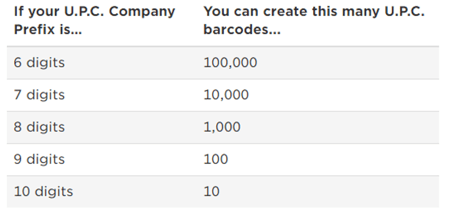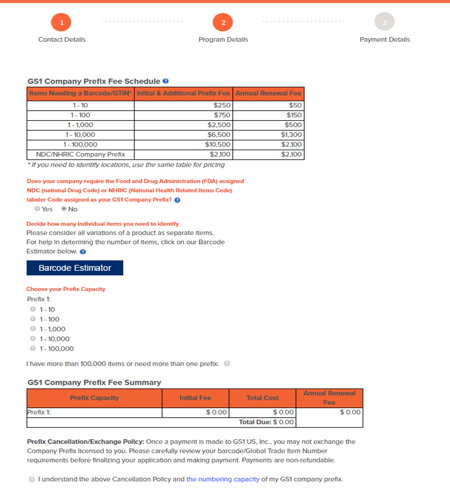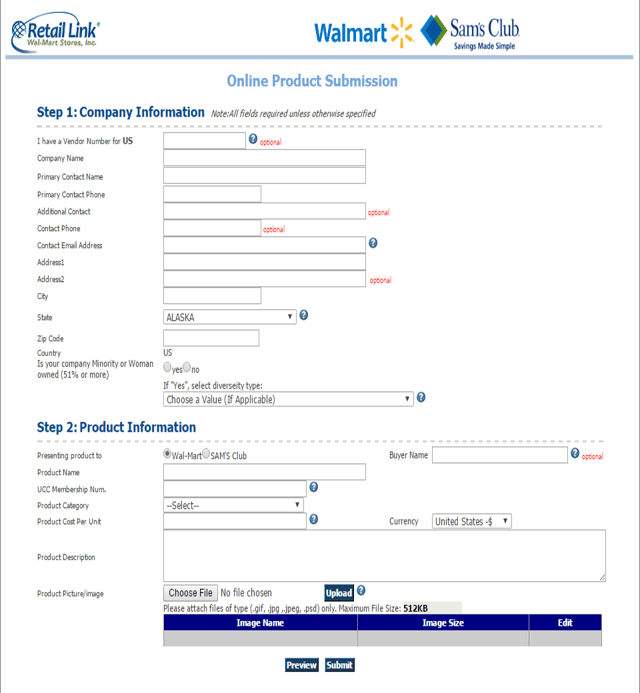You have a great product, and you believe in your merchandising team. Your product is being sold in a few locations, but you feel ready to move onto bigger retailers. You head to the Walmart Supplier page, excited to take the next step, and … the landing page scrolls endlessly, full of lists of requirements and policies and forms. Where do you even start?
Below, we break it all down step by step. Look for best practices tips for applying highlighted throughout!
Local or National?
Before you start, determine whether you're going to apply for national or local distribution. Based on the way Walmart organizes distribution, certain product categories must go through the national application procedure.
If your product is any of the following, it must follow the national application procedure:
- Apparel
- Infant/Toddler
- Toys
- Jewelry
- Ladies accessories
- Pesticides
- Chemicals
- Flammable material
- Audio, video & publications (books)
- Newspapers
- Alcoholic beverages
If your product doesn't fall into one of these categories and you want to secure distribution at the local level, look at the Local Supplier Instructions. If your product is on that list, or you're looking to become a national supplier for Walmart, check out the National Supplier Instructions.
Local Walmart Supplier Application Instructions
Step 1: Make Sure Your Product Is Up to Standards
The retailer has requirements of its wholesalers: they must meet labor standards, have a federal TIN, have a D&B number, maintain product liability insurance, create unique UPCs for products, and share all product test reports. To avoid any unpleasant surprises, make sure you’re familiar with Walmart’s minimum requirements for suppliers before you get started on the application process:
Supplier Standards
Walmart only does business with suppliers that meet certain labor standards. Here’s what the retail requires of every wholesaler it works with:
- Workers are properly paid for all labor hours
- All labor is voluntary
- Producers comply with all employment age laws and standards
- Working hours are not excessive and are consistent with local laws and standards
- Factories meet health and safety standards
If you are unsure if your company reaches these standards, you can find more detail in the Supplier's Manual.
Have a Federal TIN
In order to fill out your supplier application, Walmart requires that you have a Federal Tax Identification Number (TIN). Possible TINs include:
- Social Security Number "SSN"
- Employer Identification Number "EIN"
- Individual Taxpayer Identification Number "ITIN"
- Taxpayer Identification Number for Pending U.S. Adoptions "ATIN"
- Preparer Taxpayer Identification Number "PTIN"
D&B Number
A Dun & Bradstreet provides a financial snapshot of your business to Walmart. It acts, essentially, as a credit score for your business. You can apply for a D&B number here.
For Walmart to consider buying from your business, your risk rating must not be 7, 8 or 9.
Product Liability Insurance
In order to work with Walmart, you must have the following insurance policies:
- Commercial General Liability insurance
- Workers Compensation/Employer’s Liability insurance -- only if your employees will enter a Walmart store
- Automobile Liability insurance --- only if your employees will drive on any Walmart premises
OR
- Umbrella/Excess Liability insurance to provide all of the above insurance policies
Walmart requires specific limits of liability, depending on the product you plan to supply. The limits are as follows:

Product categories can be found here.
UPC
You must have a UPC number for your product in order to apply to supply it to Walmart. A UPC code consists of three parts: Company prefix, item reference #, and check digit. Naturally, getting a UPC number is a multi-step process.
First, create your GS1 Company Prefix. This numbers will appear at the start of the barcode for any product by your company. When purchasing this prefix, you are faced with a decision: how many digits will you need?
The more digits you purchase, the more unique barcodes your company will be able to create -- so, the more digits you buy, the more products you can sell. The price breakdown is:

This page provides a Barcode Estimator tool, if you need help deciding how many digits to purchase. Then, go here to purchase the GS1 company prefix. The process is just three steps -- fill out company info, pick a number of digits, and pay!

Now, you need to create a Global Trade Item Number (GTIN) for your product. Every product you produce should have a unique GTIN. A GTIN is composed of your company prefix, followed by an item number, then a check digit. TIP: GS1 produces a tool to help you create and organize these numbers. It isn’t free, but is an incredibly effective way to create and organize your product UPCs. Go here to use the software.
Product Test Reports and GCC
Walmart’s Product Safety and Compliance procedure monitors risks relating to general merchandise. To comply with these procedures, you must submit all product tests you have performed, in addition to your General Certificate of Conformity (GCC). Your GCC should be supplied by your manufacturer.
Step 2: Meet With a Local Manager
If you have gone through all of these requirements, you’re ready for your first action! Now, it’s time to contact a local store manager and set up a meeting. At this meeting, you will pitch your product and explain both why you want to sell at Walmart, and why Walmart should want to sell your product. Use this tool to locate a store and find contact information.
If the local manager likes your product, they will meet with the regional general manager and pitch your product. If the regional general manager likes the pitch, they will give you the approval to go forward with applying. The local manager should provide the regional general manager’s name to you -- you will need this when you apply!
Now you’re finally ready for the Online Product Submission form (find it here). This form is fairly straightforward - it requires some basic company information and a product description.

Step 3: Online Questionnaire
If this application is approved, you will receive an email with a link to the Supplier Questionnaire. This questionnaire will require:
- Your TIN number
- Your product UPC
- Your D&B number
- Basic company information
- Company Contacts
- Company Manufacturing
- Company Accounts
- Company Promotions
- Company References
- Company Sales
Step 4: Registration Portal
After completing this questionnaire, you will be redirected to Walmart's Registration Portal managed by Dun & Bradstreet. Here, you will complete Walmart’s Registration Program -- this is not free. Current fees are:
- U.S.-based suppliers: $125
- Canada-based suppliers: $150
- Non-North American-based suppliers: $275
Step 5: Supplier Agreement
If your questionnaire is approved, you will receive an email from a Walmart buyer within four weeks of submission. The buyer will link you to the Supplier Agreement. Before submitting the agreement, make sure you set time aside to talk to your buy about:
- Standard Purchase Order Allowance (New Store Allowance)
- Payment Terms
- Shipping Terms
- Condition of Sale
- Product Chemical Information
- Return Policy
Once you have that settled, go ahead and fill out the agreement. You will need your certificate of insurance, your TIN, and your D&B number.
That’s all! If you’ve made it this far, your product will make it into local Walmarts -- congratulations!
National Supplier
Step 1: Make Sure Your Product is Up to Standards
So you’re ready to start selling your product in Walmarts nationwide! Now, you need to make sure Walmart is ready for you. The retailer has requirements of its wholesalers: they must meet labor standards, have a federal TIN, have a D&B number, maintain product liability insurance, create unique UPCs for products, and share all product test reports. To avoid any unpleasant surprises, make sure you’re familiar with Walmart’s minimum requirements for suppliers before you get started on the application process:
Supplier Standards
Walmart only does business with suppliers that meet certain labor standards. Here’s what the retail requires of every wholesaler it works with:
- Workers are properly paid for all labor hours
- All labor is voluntary
- Producers comply with all employment age laws and standards
- Working hours are not excessive and are consistent with local laws and standards
- Factories meet health and safety standards
If you are unsure if your company reaches these standards, you can find more detail in the Supplier's Manual.
Have a Federal TIN
In order to fill out your supplier application, Walmart requires that you have a Federal Tax Identification Number (TIN). Possible TINs include:
- Social Security Number "SSN"
- Employer Identification Number "EIN"
- Individual Taxpayer Identification Number "ITIN"
- Taxpayer Identification Number for Pending U.S. Adoptions "ATIN"
- Preparer Taxpayer Identification Number "PTIN"
D&B Number
A Dun & Bradstreet provides a financial snapshot of your business to Walmart. It acts, essentially, as a credit score for your business. You can apply for a D&B number here.
For Walmart to consider buying from your business, your risk rating must not be 7, 8 or 9.
Product Liability Insurance
In order to work with Walmart, you must have the following insurance policies:
- Commercial General Liability insurance
- Workers Compensation/Employer’s Liability insurance -- only if your employees will enter a Walmart store
- Automobile Liability insurance --- only if your employees will drive on any Walmart premises
OR
- Umbrella/Excess Liability insurance to provide all of the above insurance policies
Walmart requires specific limits of liability, depending on the product you plan to supply. The limits are as follows:

Product categories can be found here.
UPC
You must have a UPC number for your product in order to apply to supply it to Walmart. A UPC code consists of three parts: Company prefix, item reference #, and check digit. Naturally, getting a UPC number is a multi-step process.
First, create your GS1 Company Prefix. This numbers will appear at the start of the barcode for any product by your company. When purchasing this prefix, you are faced with a decision: how many digits will you need?
The more digits you purchase, the more unique barcodes your company will be able to create -- so, the more digits you buy, the more products you can sell. The price breakdown is:

This page provides a Barcode Estimator tool, if you need help deciding how many digits to purchase. Then, go here to purchase the GS1 company prefix. The process is just three steps -- fill out company info, pick a number of digits, and pay!

Now, you need to create a Global Trade Item Number (GTIN) for your product. Every product you produce should have a unique GTIN. A GTIN is composed of your company prefix, followed by an item number, then a check digit. TIP: GS1 produces a tool to help you create and organize these numbers. It isn’t free, but is an incredibly effective way to create and organize your product UPCs. Go here to use the software.
Product Test Reports and GCC
Walmart’s Product Safety and Compliance procedure monitors risks relating to general merchandise. To comply with these procedures, you must submit all product tests you have performed, in addition to your General Certificate of Conformity (GCC). Your GCC should be supplied by your manufacturer.
Step 2: Online Product Form
Now you’re finally ready for the Online Product Submission form (find it here). This form is fairly straightforward - it requires some basic company information and a product description.
Step 3: Supplier Questionnaire
If this application is approved, you will receive an email with a link to the Supplier Questionnaire. This questionnaire will require:
- Your TIN number
- Your product UPC
- Your D&B number
- Basic company information
- Company Contacts
- Company Manufacturing
- Company Accounts
- Company Promotions
- Company References
- Company Sales
Step 4: Registration Portal
After completing this questionnaire, you will be redirected to Walmart's Registration Portal managed by Dun & Bradstreet. Here, you will complete Walmart’s Registration Program -- this is not free. Current fees are:
- U.S.-based suppliers: $125
- Canada-based suppliers: $150
- Non-North American-based suppliers: $275
Step 5: Supplier Agreement
If your questionnaire is approved, you will receive an email from a Walmart buyer within four weeks of submission. The buyer will link you to the Supplier Agreement. Before submitting the agreement, make sure you set time aside to talk to your buy about:
- Standard Purchase Order Allowance (New Store Allowance)
- Payment Terms
- Shipping Terms
- Condition of Sale
- Product Chemical Information
- Return Policy
Once you have that settled, go ahead and fill out the agreement. You will need your certificate of insurance, your TIN, and your D&B number.
If you’ve made it this far in the process, you will soon be seeing your product in Walmarts across the nation.
If you didn’t make it all the way through the application process, don’t be discouraged! You can always apply again later, or check out some other retailers that might better fit your brand identity. Once you make a connection with a retailer, work to cultivate it with store visits and merchandising.

![How to Fill Out The Walmart Supplier Application [Walkthrough]](https://www.repsly.com/hs-fs/hubfs/5._Images/1._Blog/90.jpeg?width=770&height=404&name=90.jpeg)




.png?width=480&height=252&name=PRESS%20RELEASE-2%20(4).png)

